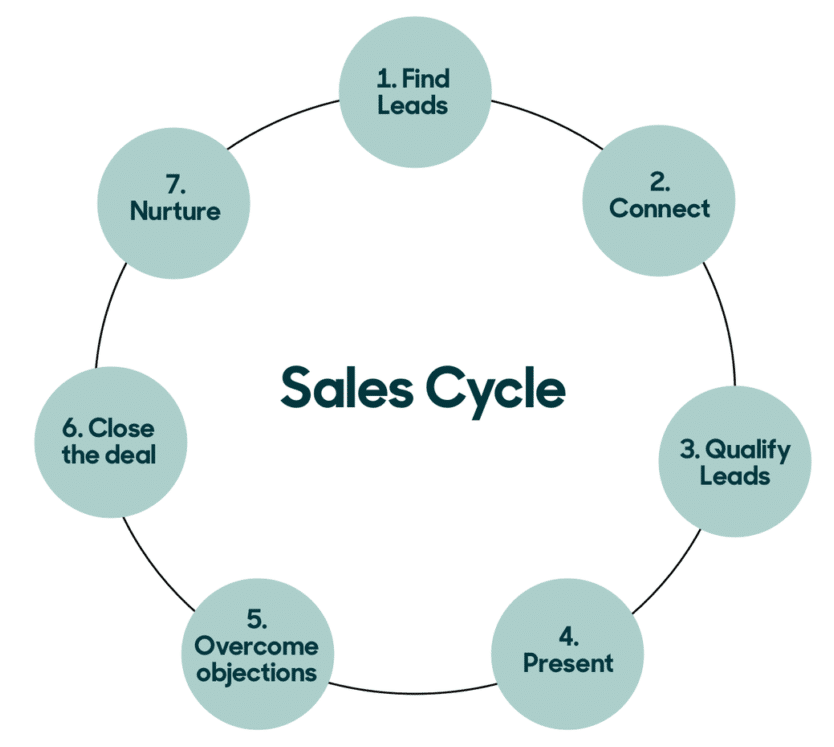SaaS sales strategies have evolved significantly over the past few years, with the industry seeing a compound annual growth rate (CAGR) of 18% from 2020 to 2027, according to a report by Allied Market Research. This growth has resulted in a highly competitive market, where differentiation and customer retention are critical. To succeed in this space, SaaS companies are increasingly leveraging data analytics to better understand their customer’s behavior and preferences. By utilizing customer data, companies can personalize their sales and marketing campaigns and tailor their products to meet specific customer needs.
Effective SaaS Sales Strategies
Identifying target audience
Identifying the target audience is a crucial step in developing effective SaaS sales strategies. According to a survey by HubSpot, companies that define their target audience are 3x more likely to see a higher return on investment (ROI) than those that don’t. To identify the target audience, SaaS companies should consider factors such as demographics, industry, and pain points. They can also conduct market research to gain insights into their target audience’s behavior and preferences. By understanding the target audience’s needs and pain points, SaaS companies can tailor their product offerings and marketing campaigns to better resonate with their audience, ultimately leading to increased sales and customer retention.
Creating value proposition
Creating a strong value proposition is essential for successful SaaS sales strategies. According to a study by CXL, 68% of B2B customers say they will pay more for products or services that offer a superior value proposition. To create an effective value proposition, SaaS companies should focus on the unique benefits their product provides to their target audience. This may include factors such as cost savings, increased efficiency, or improved customer experience. Additionally, the value proposition should be clear and concise, easily communicated to potential customers in marketing materials and sales pitches. By crafting a compelling value proposition, SaaS companies can differentiate themselves from competitors and attract potential customers who are looking for a product that meets their specific needs and provides a tangible return on investment.
Building a sales team
Building a great sales team is essential for SaaS companies to succeed in today’s competitive market. To do so, companies should focus on hiring sales reps with strong communication, problem-solving, and relationship-building skills. Once hired, ongoing training and support should be provided to ensure that sales reps are equipped to handle customer needs and can effectively communicate the value proposition of the product. Additionally, SaaS companies should foster a culture of continuous learning, with opportunities for professional development and mentorship. Sales leaders should also set clear expectations and provide regular feedback to ensure that their team is motivated and working towards shared goals. By building an exceptional sales team, SaaS companies can increase revenue, build strong relationships with customers, and drive long-term growth.
Pricing strategy
Pricing is another critical component of effective sales strategies. According to a survey by Price Intelligently, 90% of SaaS companies believe that pricing is the most critical factor for success. A well-designed pricing strategy can help SaaS companies to maximize revenue, increase customer retention, and remain competitive in the market. To create an effective pricing strategy, SaaS companies should consider factors such as their target market, the value their product provides, and the pricing strategies of their competitors. They should also regularly review and adjust their pricing to ensure it remains relevant to their customers’ needs and preferences.
Customer retention strategy
Developing a customer retention strategy is essential for SaaS companies to maintain a loyal customer base and drive long-term revenue growth. There are several key elements that are musts for an effective customer retention strategy.
Companies must focus on providing exceptional customer service, with responsive support and timely issue resolution. According to a study by NewVoiceMedia, 86% of customers will stop doing business with a company due to a bad customer experience. Companies should focus on regularly engaging with their customers, providing value-added content and resources that can help customers get the most out of the product. This can include educational webinars, industry insights, or personalized account management. SaaS companies should create loyalty programs that reward customers for their continued business. These can include incentives like discounts, exclusive content, or early access to new product features. Companies should consistently monitor customer satisfaction and gather feedback to understand how they can improve their product and customer experience. By focusing on these musts, SaaS companies can create a strong foundation for customer retention and drive long-term growth.
Best Practices for Maximizing SaaS Sales Revenue
Leverage data analytics to drive sales strategy
To effectively leverage data analytics to drive sales strategy, SaaS companies should first identify the key metrics that are important for their business, such as customer acquisition cost (CAC) and customer lifetime value (CLTV). They should then use tools such as Google Analytics or Salesforce to collect and analyze data, identifying patterns and insights that can inform sales strategy.
For example, data may reveal which marketing channels are driving the most conversions or which customer segments are the most profitable. By using data analytics to drive sales strategy, SaaS companies can make data-driven decisions and optimize their sales efforts for maximum impact.
Optimize the sales funnel
To optimize the sales funnel, SaaS companies should first map out the entire customer journey, identifying key touchpoints and potential barriers to conversion. They should then focus on improving each stage of the funnel, from increasing website traffic to improving lead nurturing and closing sales. This may involve A/B testing different marketing tactics or improving the user experience on the website.
Additionally, SaaS companies should continuously monitor and analyze data to identify areas of the funnel that need improvement. By optimizing the sales funnel, SaaS companies can increase conversion rates and drive revenue growth.
Prioritize customer success
To prioritize customer success, SaaS companies should focus on building strong relationships with their customers and providing exceptional customer service. This may involve assigning dedicated account managers to customers or providing self-service resources such as online tutorials and knowledge bases.
SaaS companies should focus on gathering customer feedback and using that feedback to continuously improve the product and customer experience. By prioritizing customer success, SaaS companies can drive customer loyalty and reduce churn, ultimately leading to long-term revenue growth.
Continuously train and educate the sales team
To continuously train and educate the sales team, SaaS companies should provide ongoing professional development opportunities, such as mentorship, training sessions, or access to online courses.
Sales leaders should set clear expectations and provide regular feedback to ensure that their team is motivated and working towards shared goals. This may involve role-playing scenarios to practice objection handling or providing opportunities for reps to shadow more experienced team members. By continuously training and educating the sales team, SaaS companies can ensure that their team is equipped with the skills and knowledge needed to drive revenue growth.
Stay up-to-date with market trends and competition
To stay up-to-date with market trends and competition, SaaS companies should regularly conduct market research and competitive analysis. This may involve monitoring industry publications, attending conferences or events, or engaging with industry thought leaders on social media. By staying up-to-date with market trends and competition, SaaS companies can identify emerging trends and stay ahead of the competition, ultimately leading to increased revenue growth.
Focus on long-term revenue growth
To focus on long-term revenue growth, SaaS companies should take a holistic approach to sales strategy, focusing on customer retention and upselling opportunities in addition to new customer acquisition. This may involve creating loyalty programs that reward customers for their continued business or identifying opportunities to upsell or cross-sell existing customers. Additionally, SaaS companies should focus on continuously improving the product and customer experience to drive customer loyalty and reduce churn. By focusing on long-term revenue growth, SaaS companies can create a sustainable business model and drive long-term success.
Challenges and Solutions
Common challenges faced in SaaS sales
SaaS sales teams often face several challenges when it comes to driving revenue growth. One common challenge is customer acquisition, as it can be difficult to stand out in a crowded marketplace and convince potential customers to switch to a new product. Another challenge is managing customer churn, as SaaS companies often operate on a subscription model and must ensure that customers are continually finding value in the product. Lastly, SaaS companies may face challenges with pricing, as it can be difficult to find the right balance between affordability and profitability.
Strategies to overcome challenges
To overcome these challenges, SaaS companies should first focus on understanding their customers’ needs and pain points. This may involve conducting market research and gathering feedback from existing customers. Additionally, SaaS companies should focus on providing exceptional customer service and building strong relationships with customers. This may involve assigning dedicated account managers or providing self-service resources such as online tutorials and knowledge bases. Additionally, SaaS companies should continuously monitor and analyze data to identify areas for improvement and optimize their sales efforts.
Case studies of successful SaaS sales revenue maximization
One example of a successful SaaS sales revenue maximization strategy is Hubspot’s “Freemium” model. By offering a free version of their product, Hubspot was able to attract a large audience and gradually upsell them to paid plans.
Another example is Salesforce’s customer success program, which assigns dedicated customer success managers to help customers maximize the value of the product. By focusing on customer success and building strong relationships with customers, Salesforce was able to reduce churn and drive long-term revenue growth.
Zoom’s viral growth strategy, which relied heavily on word-of-mouth marketing, helped the company grow rapidly and become a household name, especially with the rise of the COVID-19 pandemic. By focusing on providing an exceptional user experience and building a strong brand, Zoom was able to drive revenue growth and achieve success in the competitive video conferencing market.
Key Takeaways
Effective SaaS sales strategies are critical to success in this highly competitive industry. By utilizing customer data, focusing on customer onboarding, building a strong sales team, and creating a well-designed pricing strategy, SaaS companies can differentiate themselves from competitors, increase customer satisfaction, and ultimately drive revenue growth.

